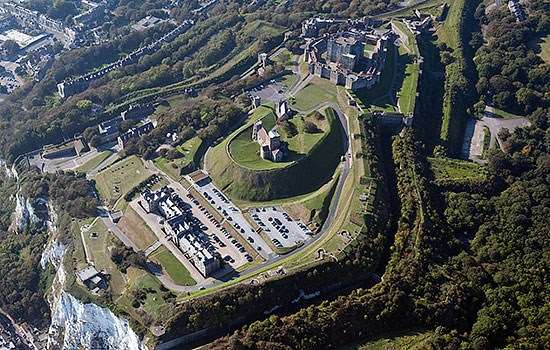UNLIMITED ACCESS TO OVER 400 HISTORIC PLACES
Live and breathe the story of England at royal castles, historic gardens, forts & defences, world-famous prehistoric sites and many others.
The chalk of Castle Hill has been shaped and reshaped over the centuries into massive earthworks, ditches and mounds. Imposing walls and towers have been raised and networks of tunnels excavated beneath them. Henry II began the building of the present castle in the 1180s, and ever since its buildings and defences have been adapted to meet the changing demands of weapons and warfare.

Learn about the long history of the castle, from its likely origins as an Iron Age hillfort, through its development as a great fortress, to its secret role in the Cold War.

King Henry II, who built Dover Castle’s great tower, also created the largest European empire of his age, stretching at its height from Scotland to the Pyrenees.

Discover why Henry II spent a fortune on Dover Castle – not to protect his kingdom, but to save face after the murder of Thomas Becket by Henry’s own knights ten years earlier.

Read about the two sieges of Dover in 1216 and 1217 during King John’s reign, and the circumstances that gave rise to this attack.

Caught up at the centre of a civil war, Eleanor de Montfort held Dover Castle against the king in 1265 after her husband and eldest son were killed in battle.
Within the walls of the medieval castle stands a much older building, dating from a time when Britain was an outpost of the Roman Empire. The Romans built a lighthouse here after they invaded in AD 43, to guide ships into the harbour.
The Dover pharos is now one of only three Roman lighthouses to survive from the whole of the former Roman Empire. It is also the most complete standing Roman building in England.
Read more about the Dover pharos on Google Arts & CultureThroughout the First World War, Dover harbour was one of the main links in the chain supplying Britain’s armies in Europe. Thousands of soldiers came to the area to defend the port at all costs, with their headquarters at the castle.
During the Second World War Dover was again on the front line, against attack from both air and sea. From 1939 the tunnels in the cliffs beneath the castle housed the command centre for naval operations in the Channel, and it was from here that the extraordinary evacuation of the British Army from Dunkirk was masterminded in May and June 1940.
Read more about Dover’s role in the Second World War – and watch this short film to see how English Heritage has restored an anti-aircraft gun used in the First World War and now at Dover Castle, where identical gun batteries were used to see off German Zeppelins.

Use our virtual tour to explore a building at Dover Castle that played a vital role in safeguarding Dover as a garrison and naval base in the First World War.

Find out the key facts about Operation Dynamo, the near-miraculous evacuation from Dunkirk in 1940, which was controlled from Dover Castle.

On 22 June 1940 the French government surrendered to Hitler, just six weeks after the Germans’ initial advance westwards. Find out why France collapsed so quickly.

In 1944, Dover Castle’s tunnels played a supporting role in an elaborate deception that concealed the true location of the D-Day landings from the Germans.

Read some of the personal stories of what it was like to work in the tunnels beneath Dover Castle in the gruelling, hot days of May and June 1940.

From weapons and technology to uniforms and personal possessions, these objects provide a glimpse into the lives of those who served in the castle’s tunnels.

Packed with plans, reconstructions and historic images, this guidebook tells the story of how the castle’s defences were adapted to meet the needs of modern warfare right up to the Cold War.

Download these PDF plans of Dover Castle to see how this great fortress has evolved over time.

This guidebook tells the story of how a network of tunnels, first cut within the white cliffs during the Napoleonic Wars, played a vital role in Britain’s defences in the Second World War.